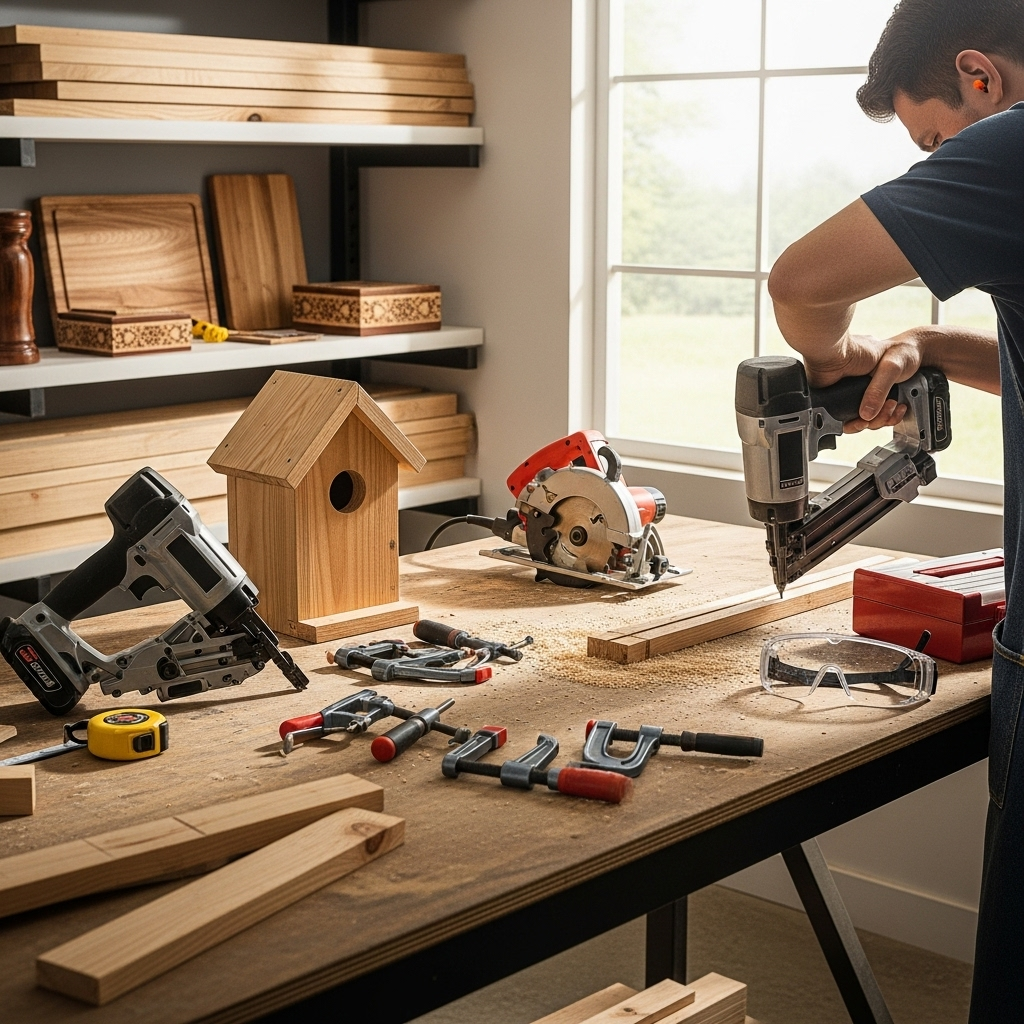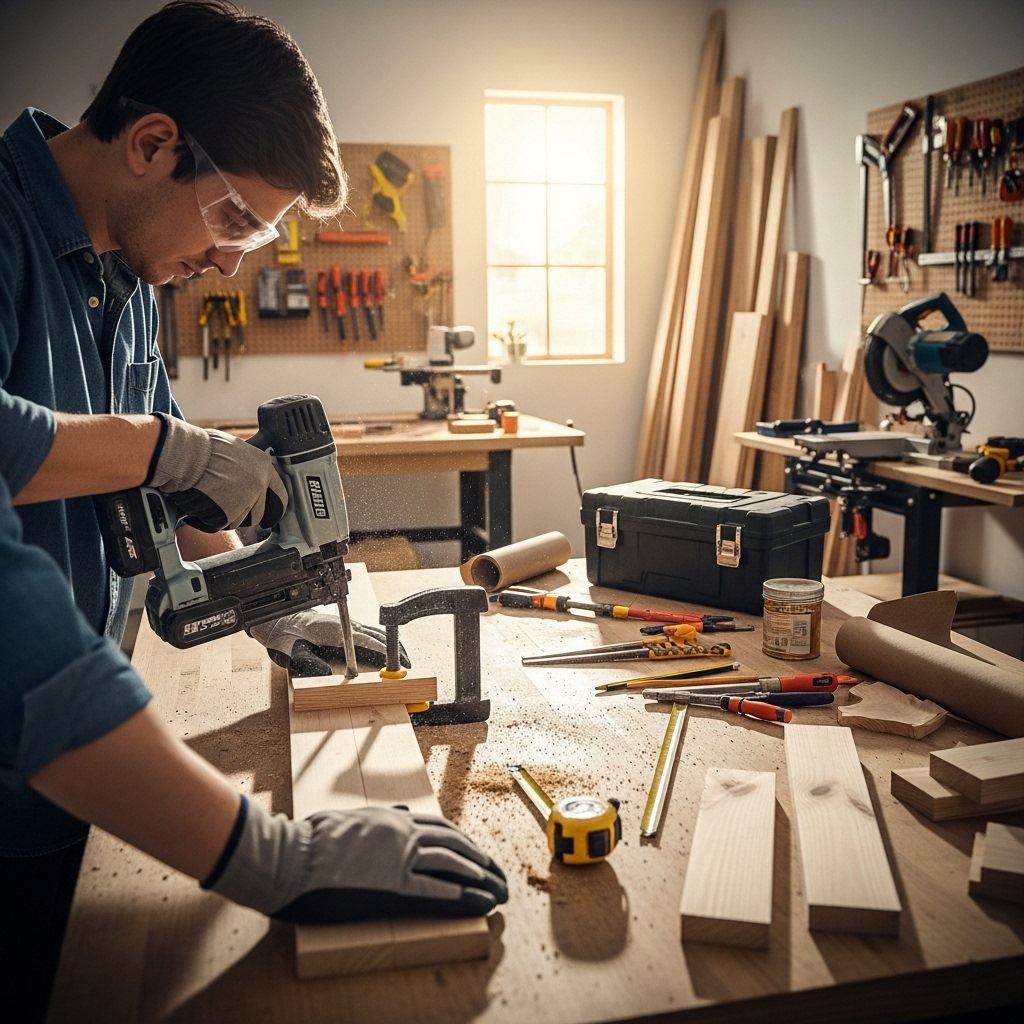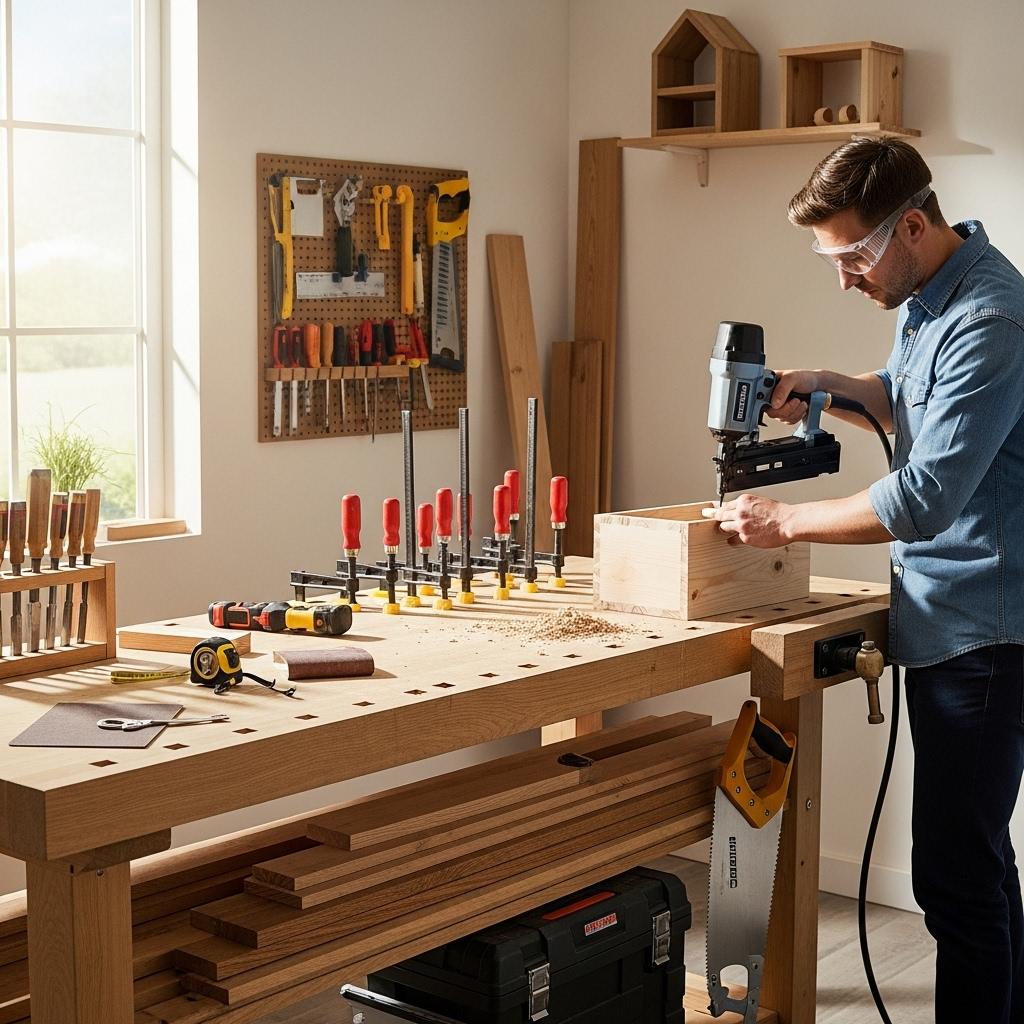Quick Summary
Discover essential, beginner-friendly woodworking projects showcasing natural wood finishes. Learn how simple techniques and materials can highlight wood’s beauty for stunning results, perfect for adding warmth and character to your home with ease.
Table of Contents
Embracing Nature’s Beauty: Woodworking Projects with Natural Wood Finishes
Hey there, fellow woodworkers! Jack Shaffer here, your go-to guy for all things nailers and DIY. Have you ever looked at a beautiful piece of raw wood and thought, “How can I make sure its natural charm shines through?” It’s a common question, especially when you’re just starting out. You want your projects to look fantastic, but you don’t want to hide that gorgeous grain. The good news is, you don’t have to! Natural wood finishes are your best friend for letting the wood’s inherent beauty take center stage.
This guide is all about unlocking that potential. We’ll explore some simple yet effective woodworking projects that are perfect for showcasing natural finishes. You’ll learn what makes a finish “natural,” what materials to consider, and how to apply them to make your projects look professionally done, even if you’re a beginner. Get ready to bring out the best in your wood!
What Exactly Are Natural Wood Finishes?
Think of natural wood finishes as gentle treatments that protect your wood without altering its look too much. They’re about enhancing, not covering up. Unlike paints or heavy stains, natural finishes allow the wood’s true color, grain patterns, and texture to be the stars of the show.
These finishes typically use ingredients derived from plants or minerals. They offer protection against moisture and wear while maintaining a beautiful, authentic wood appearance. It’s like giving your wood a comforting hug rather than a thick coat of armor.
Why Choose Natural Wood Finishes?
Opting for natural finishes offers a host of advantages, especially for home woodworking projects. They’re generally easier to work with, safer for your health, and achieve a look that’s hard to beat.
- Authenticity: They highlight the wood’s natural beauty, grain, and color variations.
- Healthier Environment: Many natural finishes contain fewer volatile organic compounds (VOCs) than synthetic options, making them better for indoor air quality.
- Simplicity: Application is often straightforward, fitting well with beginner projects.
- Repairability: Minor scratches or wear can often be buffed out or re-oiled easily.
- Eco-Friendliness: Many are derived from renewable resources.
Essential Natural Wood Finish Options for Beginners

When you’re starting out, keeping things simple is key. Here are some of the most accessible and effective natural wood finishes you can use for your projects.
1. Wood Oils (Tung Oil, Linseed Oil)
Oils are fantastic for penetrating the wood, nourishing it from within, and providing a subtle sheen. They bring out the richness of the wood grain beautifully.
Pure Tung Oil
Derived from the nut of the tung tree, pure tung oil is a durable and water-resistant finish. It penetrates deep and dries to a hard, protective layer. Be sure to get 100% pure tung oil, as many “Danish oils” or “tung oil finishes” contain varnishes or thinners.
- Pros: Excellent water resistance, durable, rich matte to satin finish, food-safe when fully cured (check product specifics).
- Cons: Can take a long time to dry (days between coats), requires multiple thin coats, can be more expensive.
Boiled Linseed Oil (BLO)
This is raw linseed oil that has been treated with metallic salts to make it dry much faster. It’s readily available and offers a warm, classic look to wood. It’s a bit less water-resistant than tung oil but still provides good protection for many projects.
- Pros: Dries relatively quickly (compared to pure tung oil), provides a warm glow, easy to apply and repair, inexpensive.
- Cons: Not as water-resistant as tung oil, can darken some woods over time, rags soaked in linseed oil can spontaneously combust if not disposed of properly (lay them flat to dry outdoors or store in a metal can filled with water).
Application Tip: For both tung and linseed oils, apply with a clean, lint-free cloth. Wipe on a thin coat, let it penetrate for 15-30 minutes, then wipe off all excess oil. Any oil left on the surface will become sticky and gummy. Allow ample drying time between coats.
2. Beeswax Polishes
A pure beeswax polish is one of the simplest ways to add a soft sheen and a bit of protection. It’s perfect for pieces that won’t see heavy wear or constant moisture. It offers a lovely, smooth feel.
Beeswax can be used on its own or mixed with other oils (like mineral oil or linseed oil) to create a creamy paste. This creates a durable, easy-to-apply finish.
- Pros: Easy to apply and buff to a shine, gives a very natural, soft sheen, pleasant natural scent, can be used as a topcoat over other finishes.
- Cons: Not very durable or water-resistant, can melt in high heat, requires reapplication.
How to make a simple beeswax polish:
- Melt 1 part beeswax (pastilles or grated bar)
- Add 4-5 parts mineral oil or fractionated coconut oil.
- Stir gently until fully combined.
- Pour into a clean container and let it cool.
3. Shellac
While technically derived from insects, shellac is considered a natural finish because it’s biodegradable and made from renewable resources. It dries very quickly and creates a hard, clear, or lightly amber coating. It’s excellent for sealing wood before applying other finishes or as a standalone protective layer.
Shellac is highly versatile. You can buy it in flakes and dissolve it in denatured alcohol yourself, or purchase pre-mixed liquid shellac. It comes in different colors, from clear to garnet.
- Pros: Dries extremely fast, non-toxic when dry, seals wood well, adheres to almost any surface, easy to repair (it can be dissolved by alcohol, so a new coat adheres perfectly).
- Cons: Not very resistant to water, alcohol, or heat; can be difficult to get perfectly smooth if applied too thickly.
Application Tip: Shellac is often applied using a “French Polish” technique with a dauber or cloth for a super-smooth finish. For beginners, multiple thin spray coats or brush coats are more manageable.
4. Simple Clear Lacquer or Varnish (with caution)
While not strictly “natural” in the same vein as oils or beeswax, many beginner-friendly clear lacquers and varnishes are formulated to provide excellent protection while still allowing the wood’s natural color to show through. Look for water-based polyurethanes or acrylic lacquers as they often have fewer VOCs than oil-based counterparts.
These offer more durability than pure oils or waxes, making them suitable for surfaces that see more daily use.
- Pros: Very durable, excellent protection against moisture and wear, available in various sheens (matte, satin, gloss), relatively quick drying times for water-based options.
- Cons: Can sometimes give wood a slight “plastic-y” look or amber tint, higher VOCs in oil-based versions, can be harder to repair than oil or shellac finishes.
Beginner’s Choice: Water-based polyurethane in a satin sheen is often the best bet for beginners wanting durability and a natural look. It’s forgiving and easy to apply with a brush or roller.
Beginner-Friendly Woodworking Projects Featuring Natural Finishes
Now that you know your finishing options, let’s talk projects! These are straightforward builds that let you practice your woodworking skills and proudly display a beautiful natural finish.
1. Simple Wooden Coasters
Coasters are a fantastic first project. They’re small, quick to make, and don’t require many complex cuts. They’re perfect for practicing precise measurements and getting a feel for sanding and finishing.
You can use simple blocks of wood, cut dowels, or even use a hole saw to make circular coasters. The key is smooth sanding and a good finish to protect against drink condensation.
Materials:
- Scrap hardwood (e.g., oak, maple, walnut) or pine
- Sandpaper (80, 120, 220 grit)
- Your chosen natural finish (oil, wax, or water-based poly)
- Optional: Cork backing
Tools:
- Saw (hand saw, miter saw, or table saw)
- Sander (orbital sander or sanding block)
- Measuring tape
- Safety glasses
Steps:
- Cut your wood into desired coaster shapes and sizes (e.g., 4×4 inch squares, 3-inch diameter circles).
- Sand all surfaces and edges smooth, starting with a coarser grit (like 120) and moving to finer grits (220). For extra smoothness, you can go up to 320 or 400 grit.
- Wipe away all dust with a tack cloth or damp rag.
- Apply your chosen natural finish according to the manufacturer’s instructions or the tips provided earlier. For oils, apply thin coats, allowing plenty of drying time and wiping off all excess. For wax, apply and buff. For water-based poly, apply thin, even coats.
- Let the finish cure completely. Sand lightly between coats with very fine sandpaper (320 grit) if using poly, wiping away dust each time.
- (Optional) Attach cork backing to the bottom of each coaster.
2. Wooden Serving Tray
A serving tray is a slightly larger project that’s still very manageable for beginners. It’s practical and looks stunning with a natural wood finish. You can make it with solid wood sides and a plywood or solid wood bottom, or use joinery for a more advanced look.
For a beginner-friendly version, consider a tray with a solid bottom and simple sides attached with glue and brad nails or pocket screws. This is where a good nailer, like a brad nailer, can be a real time-saver!
Materials:
- Plywood or solid wood for the bottom
- Wood for the sides (e.g., 1×3 or 1×4 boards)
- Wood glue
- Sandpaper
- Natural finish of choice
- Optional: Handles
Tools:
- Saw (miter saw or circular saw recommended for accurate side cuts)
- Brad nailer or small screws
- Measuring tape
- Clamps
- Sander
- Safety glasses
Steps:
- Cut the bottom piece to your desired dimensions (e.g., 12×18 inches).
- Cut the side pieces. For a simple box, you’ll need two longer sides and two shorter sides. Ensure your corner cuts are square.
- Assemble the sides into a frame. Apply wood glue to the edges and join them. You can use a brad nailer to hold them together while the glue dries, or use pocket hole joinery if you have a jig.
- Once the side frame is assembled and dry, attach the bottom piece. Apply glue to the bottom edge of the frame and place the bottom piece on top. Secure with brad nails or screws from the side frame into the bottom, or from the bottom up into the side frame.
- Sand the entire tray smooth, paying attention to edges and corners.
- Wipe away all dust.
- Apply your natural wood finish. For a tray, using a durable water-based polyurethane or a tung oil finish is a good choice. Apply multiple thin coats, sanding lightly between coats if desired.
- Once fully cured, attach handles if you’re using them.
3. Simple Floating Shelves
Floating shelves are a modern and clean way to add storage and display space. They look elegant and surprisingly simple to build, especially when you focus on a beautiful natural finish. The “floating” effect comes from a hidden bracket system that makes the shelf appear to be attached directly to the wall.
For a beginner project, you can build a hollow box shelf that slides onto a wall-mounted bracket. This keeps the weight down and simplifies construction.
Materials:
- Wood for the shelf box (e.g., 1×4 or 1×6 pine, poplar, or hardwood)
- Wood glue
- Sandpaper
- Natural finish of choice
- Floating shelf hardware (can be purchased online or at hardware stores)
Tools:
- Miter saw or circular saw
- Table saw (optional, but helpful for precise cuts)
- Brad nailer or pocket hole jig
- Measuring tape
- Level
- Drill
- Safety glasses
Steps:
- Cut your wood pieces to create a hollow box. You’ll typically need a top, bottom, two sides, and a back piece that will slide onto the bracket. Sizing depends on your bracket and desired shelf dimensions. Common dimensions for a beginner box shelf are around 3-4 inches deep.
- Assemble the box using wood glue and brad nails or pocket screws. Ensure all joints are square. You are essentially creating a three-sided box with a front edge, a top, and two sides. The back will likely be open or a thinner piece designed to connect to the bracket.
- Sand the entire shelf until smooth.
- Wipe away all dust.
- Apply your natural finish. Oils like tung or linseed oil work well, bringing out the wood’s character. Multiple thin coats are best.
- Allow the finish to cure completely.
- Install the floating shelf bracket onto your wall according to its instructions, ensuring it’s securely attached to wall studs for maximum support.
- Slide your finished shelf onto the bracket.
4. Wooden Picture Frames
Personalize your home decor with custom wooden picture frames. This project is excellent for practicing accurate miter cuts and achieving a clean, professional look with a natural finish.
Using different wood species can give you a variety of looks, from light maple to rich walnut. The natural finish will let the unique grain of each wood type stand out beautifully.
Materials:
- Wood for frame rails (e.g., 1×2 or 1×3 lumber)
- Backing material (hardboard or sturdy cardboard)
- Glass or acrylic sheet
- Picture hanging hardware
- Wood glue
- Sandpaper
- Natural finish of choice
Tools:
- Miter saw (essential for accurate 45-degree cuts)
- Table saw (optional, for cutting rabbets for glass/backing)
- Clamps (corner clamps or band clamp)
- Measuring tape
- Safety glasses
Steps:
- Determine the size of your picture. Measure the glass or acrylic for this size.
- Cut your frame rails. For each of the four sides, you’ll need to cut 45-degree miters. The length of the inside edge of each piece should match half the dimension of your frame opening. For example, for an 8×10 frame, each short side of the miter cut will be 5 inches from the point to the shoulder.
- (Optional, but recommended) Use a table saw to cut a rabbet (a groove) along the inside edge of the frame pieces. This groove will hold the glass and backing.
- Dry-fit your frame pieces to ensure they form perfect corners.
- Apply wood glue to the mitered ends and assemble the frame. Use corner clamps or a band clamp to hold the frame together tightly while the glue dries.
- Once the glue is dry, sand the entire frame smooth, paying attention to the joints.
- Wipe away all dust.
- Apply your natural finish. A light oil finish or a clear shellac can look fantastic on picture frames, highlighting the wood grain without overpowering the artwork. Multiple thin coats are best.
- Once the finish is cured, install the glass, artwork, and backing board. Secure the backing with small brads or glazier points.
- Attach your chosen picture hanging hardware to the back.
Natural Wood Table of Comparative Finishes

Here’s a handy table to quickly compare the most popular natural finishes for your projects.
| Finish Type | Primary Ingredient | Ease of Application | Durability | Water Resistance | Drying Time | Best For |
|---|---|---|---|---|---|---|
| Pure Tung Oil | Tung tree nuts | Moderate (thin coats, wipe excess) | High | Very High | Slow (24-72 hours/coat) | High-traffic surfaces, outdoor furniture, cutting boards (food safe when cured) |
| Boiled Linseed Oil (BLO) | Flaxseed oil | Easy (thin coats, wipe excess) | Moderate | Moderate | Moderate (12-24 hours/coat) | General furniture, general repair, a classic finish. |
| Beeswax Polish | Beeswax, oils | Very Easy | Low | Low | Very Fast (buffing) | Decorative items, fingerprint smoothing, light furniture touch-ups. |
| Shellac | Lac beetle secretion | Easy (spray/brush thin coats) | Moderate | Low to Moderate | Very Fast (minutes) | Sealing wood, quick projects, furniture restoration, food-safe areas (check product). |
| Water-Based Polyurethane | Synthetic resin (water-soluble) | Easy (brush/roller) | Very High | Very High | Fast (1-4 hours/coat) | High-traffic surfaces, tabletops, shelves, general furniture protection. |
Safety First: Protecting Yourself and Your Workspace
Even with natural finishes, safety is paramount. Always work in a well-ventilated area, especially when using oils that have a longer cure time or any product with VOCs.
When sanding, wear a dust mask to avoid inhaling fine wood dust. For oil finishes, remember that rags soaked in linseed oil or tung oil can spontaneously combust. Always lay them flat to dry completely outdoors, or store them in a metal container filled with water before disposing of them. For water-based finishes, ventilation is still important to manage fumes.
Always wear safety glasses when cutting, sanding, or finishing wood. It’s a simple step that can prevent serious injury. For more detailed safety information, I always recommend checking out resources from organizations like the Occupational Safety and Health Administration (OSHA) or the Woodworking Handbook.
Frequently Asked Questions About Natural Wood Finishes

Q1: Can I use food-grade mineral oil on my woodworking projects?
Yes, food-grade mineral oil is a great, safe option for wooden cutting boards, spoons, and bowls. It provides moisture resistance and keeps the wood from drying out. However, it doesn’t harden and will need frequent reapplication as it can soak into food and wash off.
Q2: How do I achieve a truly “natural” look without any sheen?
For a matte or very low-sheen finish, pure tung oil or linseed oil applied in very thin coats and thoroughly wiped off is the best bet. You can also look for “matte” or “satin” versions of water-based polyurethanes, which are designed to have minimal shine.
Q3: My project feels a bit rough after applying oil. What should I do?
This usually means excess oil was left on the surface and became gummy. After the oil has had ample time to dry (or cure), you can often lightly sand the surface with very fine grit sandpaper (320 or 400 grit) and then wipe again thoroughly. Or, apply a coat of paste wax and buff it vigorously; this can sometimes mask minor tackiness.
Q4: Can I mix different natural finishes together?
It’s generally best to stick to one type of finish per project unless you know they are compatible. For example, you can often apply a beeswax polish over a cured oil finish for extra protection and sheen. However, mixing oils and waxes without a specific recipe can lead to unpredictable results.
Q5: How long does it take for a natural finish to fully cure?
Cure times vary greatly. Oils like tung or linseed can take weeks or even months to fully cure and harden. Shellac dries in minutes. Water-based polyurethanes are usually safe to touch in a few hours and fully cure in a few weeks. Always check the product manufacturer’s instructions for specific cure times.
Q6: Do I need to seal the wood before using a natural finish?
For most natural finishes like oils or waxes, you don’t need a separate sealer. They penetrate the wood directly. Shellac, however, is an excellent sealer and can be used on its own or as a base coat before other finishes if you desire.
Conclusion: Your Natural Wood Finishing Journey Begins
Working with natural wood finishes is a rewarding experience that connects you more deeply with the material and the craft. You’ve seen that creating beautiful, durable pieces doesn’t require harsh chemicals or complicated techniques. From simple coasters to elegant serving trays and stylish floating shelves, these woodworking projects are accessible for beginners and offer a fantastic canvas to showcase the inherent beauty of wood.
By understanding the properties of different natural finishes like oils, waxes, and shellac, and applying them with care and patience, you can achieve stunning results. Remember to prioritize safety, work in a well-ventilated space, and always use protective gear. The journey of woodworking is about learning, experimenting, and enjoying the process. So gather your materials, choose a project that sparks your interest, and start bringing out the natural elegance in your wood. Happy building!
